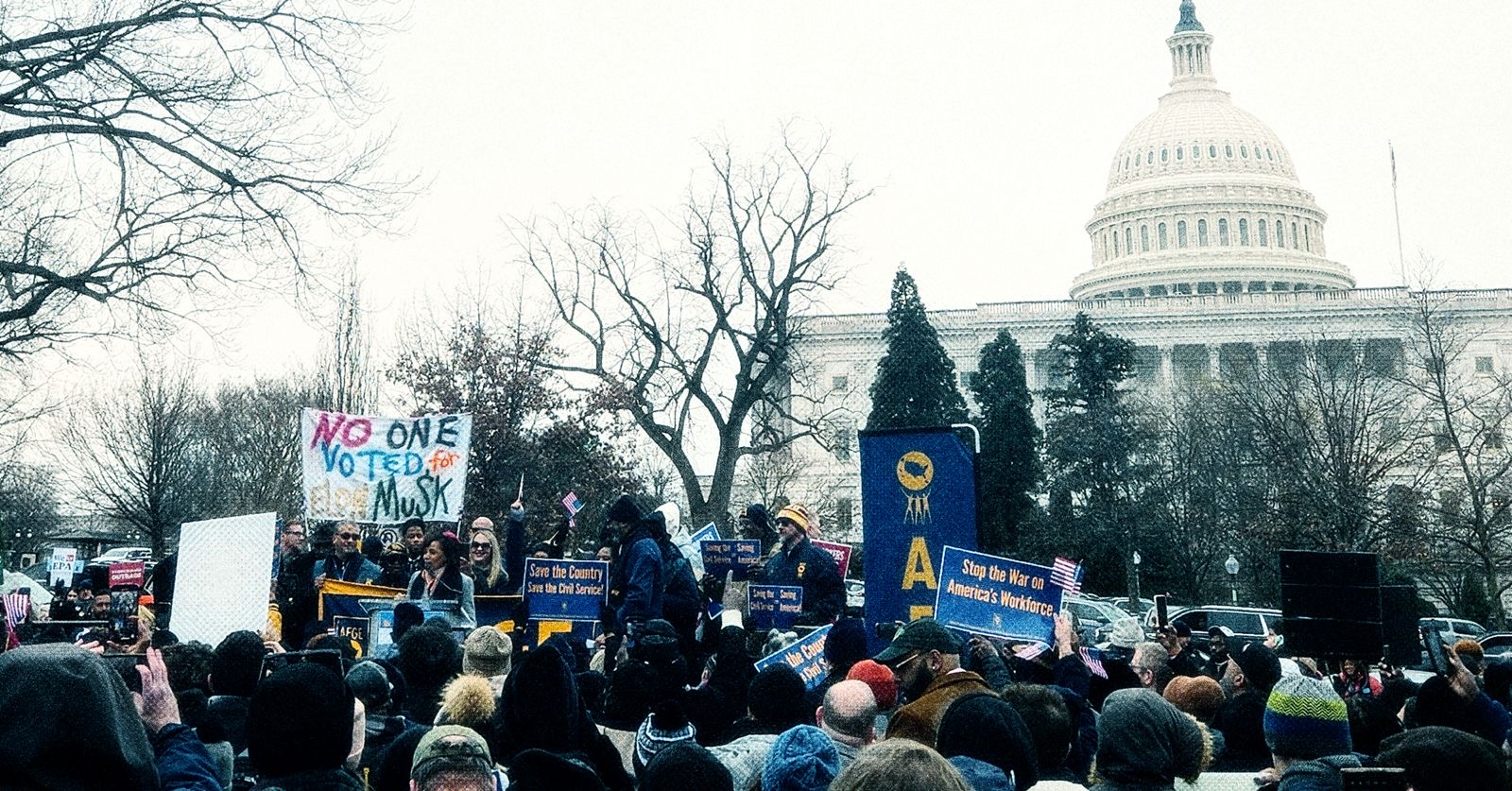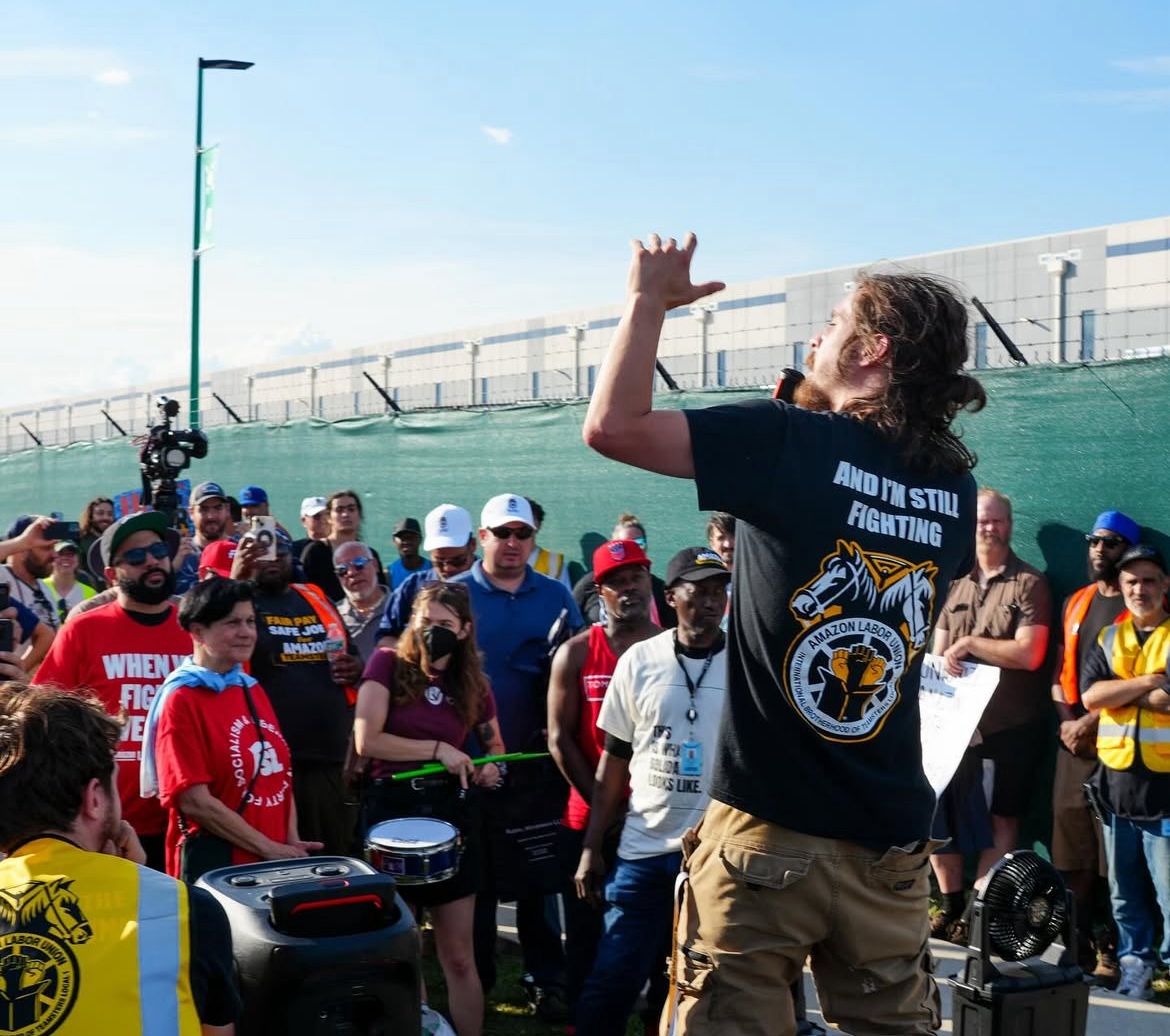Mark Smith is an occupational therapist and health educator at a Veterans Administration (VA) hospital in San Francisco. A year ago, he was elected president of Local 1 of the National Federation of Federal Employees. In his day job he trains doctors and nurses how to do patient education about diabetes, asthma, congestive heart failure, and the like.
He is a leader in the Federal Unionists Network, a cross-union, cross-agency, bottom-up group which is organizing resistance to the Trump/Musk assault on federal employees. When he was interviewed February 14, he noted that he was speaking in a personal capacity. His views are his own and do not represent the views of the U.S. government or the Department of Veterans Affairs.
What is the overall mood among federal workers right now?
It’s multi-polar. There was already a burnout crisis in the VA following COVID. We’ve had 10 years of creeping privatization and outsourcing. The Choice Act passed under Obama and the Mission Act under Trump, with bipartisan support. They’ve meant that we’re spending an increasing portion of the VA budget on outsourced care instead of direct care; it’s now up to 40%. We have a staffing crisis and a budget crisis. So the mood was already burnout.
As the outsourcing has increased, the focus on lean production has increased. Productivity requirements have been steadily increasing while staffing has not increased. The Pact Act, passed under the Biden Administration, expanded eligibility for veterans. Two million new veterans were brought in but we didn’t have the staff to take care of them. So for example, if mental health providers are not available, they go to outsourced care, and it’s a self-fulfilling doom loop where we don’t have staff so we send them to the private sector and we have to pay for that. It’s a calculated move to break the VA. Good providers are leaving who can go other places.
Then you throw this chaos and turmoil on top of it and people are angry. I don’t think people were angry before; they were demoralized and burned out, but now they’re pissed. Which is much more of an action-inspiring emotion. I’ve seen them much more willing to take action. Before it was more individual: “I’m just going to quit.” Now it’s “I’m going to join my union, I’ll march in the streets, fight back and defend the public services that we provide.”
What has Trump or Musk done that’s affected the VA?
Two things: First the hiring freeze. Thousands of job offers were rescinded across the country. Our hiring process is slow and complicated. Health care workers are in demand, they can’t sit around waiting for an offer. But then four days later, they said “just kidding, health care workers are exempt from the freeze.”
Then that “Fork in the Road” email to 2 million federal employees, offering the chance to resign. “We encourage you to leave your low-productivity job in the public sector and join a high-productivity job in the private sector.” If you want to piss off health care workers…. They come to the VA because they believe in the mission, and they don’t have to deal with insurance companies. You know, Canada has single-payer, but at the VA we have the crown jewel, government-run health care.
All the unions said “don’t do it, it’s a trap, you can’t trust these people. Look what happened to all the Twitter workers Musk laid off — they didn’t get their severance package.” I didn’t hear from too many people who wanted to resign — mostly people who were ready to retire or they were probationary and afraid they’d be let go anyway. But then they announced that 300 occupations at the VA were ineligible for the program. Meanwhile we had two weeks of people freaking out.
Also, if you’re LGBTQ you’re probably not going to want to work for the federal government if they’re telling you you’re less than human. The new VA Secretary, Dave Collins, his first email to all employees, 400,000 people, said effective immediately, only authorized flags will fly at VA facilities, no unauthorized flags will fly in break rooms or cubicles. This meant no rainbow flags. I’m in San Francisco; a significant portion of our staff is LGBTQ; our facility is a leader in LGBTQ health care.
More people signed up for the union in a week than in the past six months. We’re open shop in the federal sector. The unions had not been super-active; people didn’t see the relevance. Now they’re getting a direct lesson in the importance of a collective bargaining agreement. It’s much easier to do education now. We’ve been doing weekly “Lunch and Learns,” doing “Unions 101” for our bargaining unit, and getting 170 people regularly on those calls. These are folks who are new, who are trying to learn what unions do.
What has been the membership level of federal unions before now?
The average dues-paying membership is 20%. We are one of the higher density locals in the federal sector; ours is close to 60%. San Francisco is a union town. One of the only other areas where density is high is the IRS. But now membership is growing, growing, growing.
Few Rights
What rights do federal unions have and not have?
Our scope is much, much more limited. We do not have the legal right to strike, nor to assert the right to strike. All federal employees sign a thing when you join the federal service: you can be fired for asserting the right to strike.
Our scope of bargaining is quite limited. We don’t bargain over wages or benefits, that’s all set by Congress. We only bargain over working conditions. Even then the federal labor-management statute has extremely strong management rights clauses. Management has rights over the number of employees, contracting out, how to fill positions. We have to bargain over the impact and implementation of those things.
Without the right to strike we don’t have a ton of leverage, obviously. It’s not quite like the public sector for teachers or others who have gone on illegal strikes successfully. We have the lesson of PATCO in 1981, which put a chill on federal sector militancy. Thirteen thousand air traffic controllers struck and were fired and didn’t work for the federal government again; they lost their pensions.
We’re also limited by the Hatch Act. We can’t talk about partisan political things. There’s a lot that keeps federal employees fearful, for good reason. But in any situation a bad boss is the best organizer and we have a real bad boss right now.
When was the Federal Unionists Network founded, what’s it done, what’s it doing now?
It started as a WhatsApp chat in summer of 2023. We formed as a result of a bunch of federal sector folks getting together on a campaign to pressure Chuck Schumer to confirm appointees to the Federal Labor Relations Authority; it can’t do its work without a general counsel. Chris Dols and others from IFPTE [Professional and Technical Engineers] Local 98 cold-called local presidents. That campaign didn’t work but a bunch of us started getting together, focused mostly on building our locals.
At the 2024 Labor Notes Conference we hosted a federal workers meet-up; it was the first time all of us had met in person. That was really exciting. We had about 60 people from all different agencies, all different federal unions. Chris Dols and Colin Smalley launched their campaign for IFPTE vice presidents. And it kept growing, with folks looking to build more of a fighting federal union.
FUN Growing Exponentially
Then Trump was elected. The WhatsApp community began growing exponentially.
We organized a roundtable in December, our first public event: “Fighting Back while under Attack,” with Sara Nelson and Joe McCartin and six of us local leaders as panelists. We got strong attendance, 280 people, and we had breakout sessions about organizing new bargaining units, building stronger locals.
We knew a shit-storm was coming. We wanted to scale up and build our infrastructure, we knew there would be a massive influx into our unions.
We organized another roundtable after Trump took office; we knew the executive orders would start coming. On February 3 we had almost 300 people.
So we are organizing against mass layoffs of probationary employees; the shutdown of entire agencies, like Consumer Protection, USAID, the Department of Education; unauthorized access to data of public employees.
You have a Day of Action planned for February 19. What will happen?
There will be both virtual and in-person events. The virtual component is folks can take a selfie with their coworkers wearing red, white and/or blue and holding up signs telling: how does your work help the public?
If you’re a community person, your sign can say how federal workers’ work helps you. The demands are no cuts to vital services, no mass layoffs, end the funding freeze, respect federal workers’ contracts, no cuts to science and health research. That’s the social media portion.
Post your photos online with the hashtag #SaveOurServices.
The action we’re doing is rallies or pickets in front of Tesla dealerships. Stop Musk, get your hands off. We want to generate lots of backlash against Musk. We have plenty of Republicans in our union and a lot of people voted for Trump. But whatever they think of Trump, even folks who voted for him might not approve of Musk, especially when he went marauding through people’s data.
Federal employees are skittish about partisan political activity. But Musk is not a partisan political figure. He is an unelected figure.
Solidarity Works
What can other union members and DSA members do to support federal workers who are on the tip of the spear?
The biggest thing is to get active in your unions. Many federal workers have never thought about their unions as places to do this kind of work. If you’re in a private sector union, make sure your union is supporting federal workers. We can’t strike legally. We need the rest of the labor movement to be in solidarity with us, to help us.
In 2018 Sara Nelson and the flight attendants union (AFA) threatened to strike if air traffic controllers weren’t paid — that got the federal government’s attention. That threat ended the impending government shutdown, basically. We need unions to be on our side and create a political crisis for this administration. It’s not just a solidarity/charity kind of thing; we saw what happened with PATCO.
The treatment of federal workers and their unions is a bellwether for the rest of the labor movement. It’s a signal. Corporations look to the federal government and see what it’s doing. When Biden walks a picket line, that’s a signal to corporations that this administration is going to take a different approach than if the sitting federal government says it’s open season on federal workers.
In 1981 the corporations took their cue from Reagan. Again, it’s a bellwether for how corporations will feel emboldened to act towards their own unions and own workers. Ultimately I think that’s what the mission and goal is for Musk, to lower workers’ conditions across the board. As treatment of federal workers goes, so goes the rest of the workforce. Chris Dols had a good quote: “We’re the canary in the coal mine.” Just like it’s emboldening for workers when they see other workers going on strike and winning, corporations see union busting and it’s emboldening for them.
DSA chapters can see if you have federal workers among your members. And we can use volunteer help with technical things and logistics. Reach out to info [at] federalunionists [dot] net.
How do we follow what FUN is doing?
- Follow our social media handles: Federal Workers United on Instagram, X, and Bluesky.
- To find our February 19 rallies, go to bit.ly/SOSaction.




